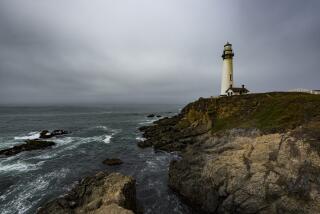To the LIGHTHOUSES
- Share via
BIG BAY, Mich. — I was running late, driving through the woody darkness toward Lake Superior, when I stopped to call ahead and warn my hosts. I made my apologies to the answering machine, and then signed off, saying, “Don’t wait up--just leave the light on.”
When Linda Gamble checked her messages, she probably didn’t laugh. No doubt she’d heard the joke ad nauseam. She is keeper of the Big Bay Point Lighthouse Bed & Breakfast.
My daughter and I had been looking at colleges in the Great Lakes region last summer, and when she headed home I decided to wander along the American shore of Lake Superior in search of old lighthouses. My route began on the lake’s western shore, in Minnesota, and went east through Wisconsin and Michigan’s Upper Peninsula, ending at Whitefish Point, where Lake Superior narrows and drains into St. Marys River. Then I backtracked to Big Bay, the Michigan town where I would cap the journey with a night in a lighthouse-turned-B&B.;
You can cover a good selection of Great Lakes lighthouses in a week of relaxed driving if you leave out more distantly located beacons, such as the ones on Isle Royale or the tip of the Keweenaw Peninsula. I extended my own tour with some offshore adventures at Wisconsin’s Apostle Islands and Michigan’s Pictured Rocks National Lakeshore. But in between, I moved at a fairly good clip, using F. Ross Holland’s “Great American Lighthouses” as a guide to the best and the brightest.
In summer, Lake Superior is a great beauty, a seductive pool as blue as a robin’s egg. On a warm day, the breeze barely puffs a sail, and boats drift languidly. But the serenity can disappear quickly in violent winter storms and blinding fogs, with dire consequences for the sailors who carry iron ore, grain and passengers across it. Many great ships have gone down, from the days of sailing ships to the wreck of the freighter Edmund Fitzgerald in 1975.
Thus there are lighthouses along the shores, atop the reefs, at the mouths of safe harbors. There are far fewer than there were a century ago, when there were more than 300, and these days some are more important to tourists than to mariners.
Now the remaining working lighthouses on the Great Lakes are automated, and many others have been shut down by the U.S. Coast Guard to cut costs. Yet lighthouses retain their allure.
For me, there is something siren-like about them. They’re a reminder of boyhood sailing along the coast of California; I would listen to the moan of the foghorns and watch the swiveling yellow eyes of lighthouse beacons.
*
Different time, different place. Thirty years later I began my lighthouse tour at the helm of a coupe, not a sloop. A half-day drive from Minneapolis brings you to the southern snout of Lake Superior at Duluth. Split Rock Lighthouse is another hour north on a scenic shoreline drive. It stands on a 124-foot cliff jutting out into the water. I climbed the twisty stairs to the top of the brick tower, learned about the life of a 19th century keeper in the visitors center and hiked down a trail to the boathouse on the shoreline below.
A century ago, materials for Split Rock were brought by boat and lifted up the cliff by derrick. For months, the keepers would see no one but an assistant or family members. But there was good hunting and fishing, a well-stocked library provided by the Lighthouse Service and time to contemplate the magnificent lake, described by one writer as “the coldest blue eyes in creation.”
When a highway was built along the west shore of Lake Superior in the 1940s, a steady stream of visitors put an end to that lonely life. Split Rock was decommissioned in 1969, but tourists keep coming.
No two lighthouses are alike: There are those shaped like squat chess pieces, such as Split Rock; smooth conical towers like the Au Sable near Grand Marais, Mich., and the spidery, skeletal configuration of Whitefish Point, a thin pillar supported by a lattice of steel braces near Lake Superior’s eastern outlet.
You can approach some by land, as most people do, but in other cases, water is the only way. You need a powerboat, sea kayak or sailboat to get around Wisconsin’s Apostle Islands (there are ferries and rentals), where you can find all types of lighthouses, from a 100-foot skeletal light on Michigan Island to an abandoned, ramshackle wooden tower on Raspberry Island.
If you are seaworthy to sail the deeper waters of the lake, you can visit Stannard Rock, 30 miles offshore on a dangerous shallow reef that stood in the path of big boats heading for Sault Ste. Marie. Built in 1880 by ferrying enormous chunks of limestone from the shore, Stannard sticks out of the water like a missile silo. Its solitude wore out a lot of lightkeepers before it was automated in 1962.
Another isolated beauty is the Rock of Ages on Isle Royale National Park, an island known for its resident pack of wolves. This smooth white tower casts its beam 29 miles, the most powerful light on Lake Superior. It may have been equal parts bravery and utter loneliness that drove a Rock of Ages lightkeeper in 1933 to row through a frigid storm to the rescue of shipwrecked passengers and crew from the freighter George M. Cox, and then shelter all 125 of them in the light tower. But lighthouse lore is rife with stories like that.
The second largest freshwater lake in the world can generate huge swells and screaming icy winds. Superior’s fury drove 19th century schooners ashore, and split the Edmund Fitzgerald, a giant modern iron ore freighter, in two.
Travelers running the gauntlet of lighthouses along Superior’s American side may want to take a break at Munising, Mich., to visit a shipwreck or two just offshore near Grand Island, an area now protected as part of the Alger Underwater Preserve. Grand Island lies just off Pictured Rocks National Lakeshore, a ribbon of high, sculpted sandstone cliffs. Springs carrying minerals such as copper and iron have put colorful streaks in the sandstone, where erosion has created startling faces, caves and beaches. There are guided boat tours, which should include a look at the 1874 Au Sable Light, a tall white tower that’s still on the job.
Museums honoring the ships that have gone down are found all along the lake shore. One of the dozen or so museums is the Great Lakes Shipwreck Museum at Whitefish Point. The museum faces a rough piece of water east of Pictured Rocks known as the Graveyard of the Great Lakes. The Whitefish Point lighthouse, situated between the museum and a pleasant beach, is one of the oldest on the Great Lakes (the structure dates from 1848), guarding the mouth to Whitefish Bay, where Superior drains into Lake Huron.
At the center of the museum is a giant Fresnel lens--named for its French inventor. Arrayed around it are displays about Lake Superior’s most notorious shipwrecks, including the Edmund Fitzgerald.
The living quarters of the lighthouse keeper have been restored as they would have been at the turn of the century. The keeper’s family had the sunny side of the building, and the assistant keeper was stuck on the northwest half. In another building on the museum grounds, a touching video about the Fitzgerald shipwreck and the families of its crew is shown.
*
A swath of sandy beach by the lighthouse was crowded with swimmers and strollers during my visit. The air cooled at twilight as I tiptoed my way out on some half-submerged pilings. It was a peaceful moment, with the light dropping, people strolling on th beach and the dependable beacon of light turning.
Then I lost my footing and fell waist deep into the cold water. Reminding myself between shivers that in a few hours I’d be warming my toes in a lighthouse B&B;, I hit the road west to Big Bay.
Arriving late at the Big Bay Point Lighthouse, I went straight to bed but found I couldn’t sleep. The rooms at Big Bay Point are warm and comfortable, but I was too excited at the thought of finding myself spending the night in a lighthouse to sleep much. The square, brick light tower at Big Bay Point is attached to the lightkeeper’s quarters, so the stairs to the tower were only a couple of walls away.
In the morning, after breakfast, I had an opportunity to explore the Linda and Jeff Gambles’ lighthouse home. It is surrounded by woods, and they have put benches on the adjacent meadows that run right up to the edge of the cliff. In the summer, visitors can sail on a nearby lake, fish or float the rivers, or hike to waterfalls. In winter, the lighthouse stays open for skiers and others daring enough to venture this far north.
To get to the tower, I passed through a snug library, climbed up narrow wooden stairs past a sauna, and up a spiral staircase in the tower itself. The hatch to the light platform was barely wide enough for my shoulders. From the circular walkway around the beacon, I could see open water. At the horizon, the water blends with the sky, and I felt the lake gazing back at me with those cold, blue eyes the writer had described. I had an urge to get out of the way of the big lens, as if my minuscule shadow might interfere with its work. But I returned down the stairs to sip coffee with the Gambles and talk about the haven they’d found here by the lake.
(BEGIN TEXT OF INFOBOX / INFOGRAPHIC)
GUIDEBOOK: Superior Lights
Getting there: Northwest is the only airline offering nonstop flights from LAX to Minneapolis. Lowest restricted, advance-purchase round-trip fare is $224.
Highlights: Split Rock Lighthouse, (18 miles northeast of Two Harbors); telephone (218) 226-6372. Open 9 a.m.-5 p.m. daily, mid-May through mid-October. Great Lakes Shipwreck Museum/Whitefish Point Lighthouse, Paradise; tel. (906) 635-1742. Open May 15 to Oct. 15, 10 a.m.-6 p.m. daily.
Where to stay: Big Bay Point Lighthouse B&B;, tel. (906) 345-9957. Open year-round. Summer rate: $115 for a double room.
Sand Hills Lighthouse Inn, tel. (906) 337-1744. Open year-round; rates $115-$175. --G.O.
More to Read
Sign up for The Wild
We’ll help you find the best places to hike, bike and run, as well as the perfect silent spots for meditation and yoga.
You may occasionally receive promotional content from the Los Angeles Times.






